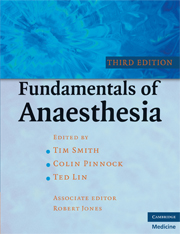Book contents
- Frontmatter
- Contents
- List of contributors
- Preface to the first edition
- Preface to the second edition
- Preface to the third edition
- How to use this book
- Acknowledgements
- List of abbreviations
- Section 1 Clinical anaesthesia
- 1 Preoperative management
- 2 Induction of anaesthesia
- 3 Intraoperative management
- 4 Postoperative management
- 5 Special patient circumstances
- 6 The surgical insult
- 7 Regional anaesthesia and analgesia
- 8 Principles of resuscitation
- 9 Major trauma
- 10 Clinical anatomy
- Section 2 Physiology
- Section 3 Pharmacology
- Section 4 Physics, clinical measurement and statistics
- Appendix: Primary FRCA syllabus
- Index
- References
1 - Preoperative management
from Section 1 - Clinical anaesthesia
- Frontmatter
- Contents
- List of contributors
- Preface to the first edition
- Preface to the second edition
- Preface to the third edition
- How to use this book
- Acknowledgements
- List of abbreviations
- Section 1 Clinical anaesthesia
- 1 Preoperative management
- 2 Induction of anaesthesia
- 3 Intraoperative management
- 4 Postoperative management
- 5 Special patient circumstances
- 6 The surgical insult
- 7 Regional anaesthesia and analgesia
- 8 Principles of resuscitation
- 9 Major trauma
- 10 Clinical anatomy
- Section 2 Physiology
- Section 3 Pharmacology
- Section 4 Physics, clinical measurement and statistics
- Appendix: Primary FRCA syllabus
- Index
- References
Summary
The safe conduct of anaesthesia requires meticulous preoperative assessment, preparation and planning. In the case of elective procedures this should occur well in advance of surgery, allowing a comprehensive review of concurrent disease, medication and social issues. This is often carried out in a dedicated preoperative assessment clinic by a multidisciplinary team comprising nursing and medical staff as well as pharmacists and specialist technicians.
Whilst patients undergoing emergency surgery may not benefit from such a structured approach to their preoperative management, they must nevertheless undergo rigorous systematic review and preparation to ensure optimum care.
Preoperative assessment
Screening
When elective surgery is first planned, a screening questionnaire may be used to provide information regarding comorbidity that may require early preoperative review or intervention. A need for additional specialist input can be identified and acted upon at this stage.
Preoperative assessment clinic
During subsequent preoperative assessment a general medical history is taken, detailing concurrent disease and its management.
Correspondence in the clinical notes may provide a useful outline of a disease process, giving some indication of its stability, as well as information on previous hospital admissions, current medication and recent investigation results.
A history should be taken of previous anaesthetic experience. A family history of problems associated with anaesthesia must be noted and may require further investigation.
The patient's general health should be assessed. In particular a history of reflux should be noted, along with smoking and alcohol habits.
A history of recreational drug use may be appropriate.
A list of current medication, including dosage and recent changes, is essential, along with a history of any allergic or other adverse drug reactions. The nature of the allergy or reaction should be recorded.
[…]
Information
- Type
- Chapter
- Information
- Fundamentals of Anaesthesia , pp. 1 - 24Publisher: Cambridge University PressPrint publication year: 2009
